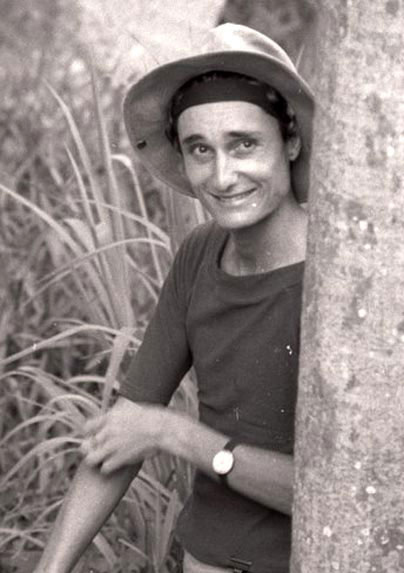
 |
| MAËL DA COSTA: LE FILM |
|
52' (versionTV) / 90' (version libre)
consistera d'une série de performance/installations qui s'inspire
du travail de Maël da Costa, styliste, performeur brésilien,
qui en 1994 est décédé à Saint Denis, Ile
de la Réunion, du sida. Sa présence sur l'Ile pendant
8 année a eu un impact énorme dans le monde du théâtre
aussi au delà des frontières du l'Ile. Beaucoup des
personnages de l'Ile étaient en contact proche avec lui.
Le film va faire revivre le rêve de Maël, qui se manifestait à travers
son travail, et donnait forme aux rêves des personnages proches
de lui, aujourd'hui, dix années après. Le corps peut
bien mourir, mais les rêves
persisteront. L'île de la Réunion est un carrefour. Des
rencontres, des unions, des séparations, des disparitions, par
sa nature, se manifestent exce-ptionnellement dans ce contexte géographique
et culturelle. Les traces des passages s'effacent vite, les histoires
ont des difficultés de s'incarner dans la terre locale, malgré
l'envie collective d'une identité historique qui réunissait.
Pour cela, l'histoire de Maël da Costa, qui s'inspirait directement
de la force de la nature magnifique sur l'Ile, de la beauté des
gens de l'Ile de toute origine, pour ces créations, me semble
parfait pour un film entre rêves et réalités.
Mais aussi les contradictions, les confrontations entre " le
bien et le mal ",
comme pour Maël, de traiter la beauté de la vie, face à
une mort inévitable et proche. Sur une Ile, les rêves sont
plus grandes qu'ailleurs, sur une Ile les réalités sont
plus inévitable qu'ailleurs.
MAEL FILM PROJECT / COMMENTS ON
Life And Death 2007, 52'
Mael da Costa brazilian artist performer and stylist lived for 8 years on Reunion Island before he died in 1994 at Saint Denis from aids. His universe of creation was baroque and beautiful. Thus he was in profound admiration before the creation of nature. He created ephemeral clothing from vegetal and industrial waste and created them directly on the bodies of the models, often working outside at magnificent sites of the island's nature, its primary forests, its rivers and cascades, bamboo forests, volcanoes for documents of photographs and more rarely for film. Since his arrival on the island he knew about his approaching death and thus lived in a constant urgency to create, in an universe between life and death, man and woman, appearance and disappearance, strength and weakness. A profound search and artistic existential manifestation of a unique identity. For my film project I chose this personality to create an artistic documentary film on Reunion Island, an island where natural extremes and physical and psychological contradictory energies join each other, as they were incorporated in the life of Mael. A profound search of identity and the reality of a general insecurity of its people by the constantly moving volcanic grounds one stands on, the dangerous oceans one is surrounded by, the barely hidden social conflicts, characterize the multi racial and multi religious society on the island, and gives it a unique, explosive creative potential. The different communities of African, Chinese, Indian and European origins can't avoid each other as in the big world capitals and an intense but peaceful, unique beautiful métissage is happening between the peoples. The world's future reality is the unity of the best of all its communities! This beauty is the best and most efficient argument against racism, nationalism and protectionism. As an avant-project I created commentaries on life and death, where, through the eyes and performance of Theo Trifard, well-known French actor, and Nadjani Bulin, dancer choreographer, both former close friends of Mael, a gap of 13 years is closed. Theo realised several theatre production with Mael, and Nadjani was a choreographer, dancer and model of his. The performers interrogate the moment of passing away, when one looses one's body, and thus one's ambition, illusions, and realises oneself as one is, beyond social and intellectual standard, more or less realistic concept of oneself. "Video", I see, finds its meaning in this context. The texts by Calderon, pronounced by Theo and the texts by Picasso, read by young performer Brice Payet in the video projection in the film, are linked to that moment where we believe, either moving from dream to wakefullness or from being awake to dreaming. One finds oneself in a strange situation, without real orientation, but still somewhat known. It's finding a plane you know, but you hadn't really frequented throughout your life. Still you know, it was there. So the memories, the essential events of your life are there all at once, without a timeline, with dreamlike appearance and disappearance and with changing importance. And there is no notion of time. In this film Theo and Nadjani are moving into this world through the performance, accompanied by models Laina and Audrey, the child-king Ajay Chandra and dancer Brice, who incarnates his role of a stalker, the one who accompanies from life to death. And from death to life. For he also appears in the orgasm of the sexual act, the procreating act, the call for life in the moment of disappearance of flesh as an appearance of no time. Time is an important editing factor in the film. I wanted to take away all sense of excitement, and give time to the spectator to orientate himself, be able to see the evolution of the images as if he would create them in that instant, inside of himself, without haste. And that's also what he does, for the outer image of light is just a mere impulse for the psychic images appearing in the spectator. Thus he is an actor towards the creation of the film. Another important factor is the film as a light source: the darker the image, the more the spectator is by himself, the more light there is, the more he is afar from himself. The model actors are also spectator-actors, watching their own death by the "video", part of the timelessness and of spacelessness, of the eternal Here and the infinite Now. |
| LA MISE EN SCÈNE & RÉALISATION |
|
THE MAELFILMPROJECT 90', format tv 52' (Holland antennetv,
reunion island rfo, South Africa sabc) Production: Hemisphere Prod., Nawar
Prod. Reunion Island Co Production: Total Eclipse Films,Terrence Francis,
South Africa Production Mauritius: "1 autre monde"Prod., Frank Alfirevic
Director/Author: Nikunja Director of Photography: Jean Marc Selva Camera:
JM Selva, Emmanuel Prudhomme and 2 assistants After the realisation of this pre project, meant to explain and show my way of working and personal approach to the creation of film, I now concentrate on the realisation of the film on MAEL. To show "Comments on life and death" in Cannes and Durban Festivals allowed me to find the excellent DOP Jean Marc Selva, the unique Indian actor Nandana Sen, young emerging British actor Paul James and have the support by Nawar Productions and Hemisphere Productions of Reunion Island and Total Eclipse Films of South Africa to assure the production of the project. The distribution will be assured also by Biemans Production in Holland and by an Indian producer. To complete cast and crew I am in contact with top model Venantia Otto of South Africa/Namibia and Sangeeta Sadarangani of onyxbeauty for the realisation of the make-up, due to special attention because of the special tropical conditions of the shooting places in nature. The development of the project has been supported by the Regional Council and State of Reunion Island, French Embassy of South Africa and Grafica Prints Reunion. |
| LES LIEUX |
|
Les places de performances sont une sélection de
lieux de travail de Maël, dans la nature, qu'il avait choisit pour
ses projets photographiques, aussi dans un théâtre ou lieu
publique, ou aurait eu lieu ses performances, et ses ateliers. Chaque
performance est liée à une heure de la journée, le
film décrit ainsi une journée entier. Cette heure spécifique
pour chaque performance correspond à une lumière, à
un moment de la vie, si on prend le sommeil de la nuit, comme petite mort.
Les performances sont créer en rapport avec les participant. En
partie ce sont des models et amies de Maël, en partie ce sont des
modèles et danseurs choisit. Tout le monde sur le plateau est acteur,
performeur. Il n'y a pas de différence entre la fiction et la représentation
d'une objectivité artificielle. Les performances sont créer
et préparer par Nikunja, en collaboration avec les participants
dans le sens, ou chaque personne présent emmène une présence
de personnalité scénique ; Nikunja créera avec et
par cette présence scénique. For the realisation of the project , there will be staged performances at approximately 16 places in nature on Reunion Island, from primary forests , the ocean to the volcano, places where Mael worked and created.. A second volume will be filmed at a lynch-like house on Mauritius. The first volume is 20 days of shooting, the second volume is 4 days . The performances are linked to themes of the human existence, realities which are of universal impact, but can be lived only subjectively, like love, transcendence, birth and death, etc. These themes are linked to the reality of Mael and the consequences of and for his life as a human being and as an artist. For the film I don't work only on a timeline, but I create it in layers, like a painting. Like in real life, where one floats between his psychic and physical awareness all the time, being in several "realities" at the same time, the film moves between multiple layers of events and creation. |
| LES COSTUMES |
|
La création des costumes se fait en collaboration
avec la styliste Indienne MALINI RAMANI. Nous nous référons
aux grandes collections de photos de Raymond Barthes et Emmanuel Magueresse,
qui avaient accompagner Maël pour beaucoup des travaux en pleine
nature ou en atelier. Les créations des costumes vont aussi évoluer
par les nouveaux participant et les performances spécifiques sur
places. Comme les costumes de Maël, ces costumes vont être
créer des matériaux éphémères de déchets
végétaux et industriels. Sur le plateau il va persister
une atmosphère de laboratoire et d'atelier. An important aspect is linked to the creation of the "costumes" in cooperayion with Malini Ramani, Indian contemporary stylist; partly ephemeral clothing, from vegetal and industrial waste as of the creation by Mael, but not only. Malini would create from her own language as a creator in regard to the creation of Mael; not in a narrative or representative way but in a free and creative inspirational way, taking the artistic intentions of Mael and transforming them though her own artistic perception into something new. Since I work a lot with texture of material and colour it will be a close cooperation with the DOP and me, as the creator of the cinematographic image. There is also an evident link between landscape and clothing. As for the actors I would like to spend some time with the stylist to develop the understanding of the artistic content in regards to each scene and place of shooting and performance. |
| LES PERFORMEURS |
| Nous choisirons 5 modèles hommes et femmes et quatre danseuses/danseur pour les performances dans un casting. En outre il y a les personnalités proches de Maël, qui apparaissent dans les performances, entant eux mêmes, dans la figuration que Maël avait vu en eux, ou/et dans leur situation d'aujourd'hui, dans leur rêve d'aujourd'hui. |
| CAMERAS |
| Le réalisateur/auteur Nikunja a choisit de travailler avec le chef opérateur Jean Marc Selva de Paris, qu'il a rencontré à Cannes. Sa connaissance et son expérience de différents formats de 35mm à téléphone mobile vont lui permettre d'assurer la réalisation d'un produit de haute qualité et permettre de subtilisée les visions de textures de films proposés par Nikunja. Après une discussion sur le sujet, les deux artistes se sont très rapprochés et partagent une vision commune d'expérimentation et de réalisation. D'où l'intérêt de ce photographe aguerri (plusieurs de ses longs métrages été en compétition sélectionne officielle à Cannes ces dernières années, cette année UNNI de l'Indien Murali Nair) d'envisager de travailler avec Nikunja et à s'investir pour ce projet. Le choix c'est porté sur l'emploi de deux à trois caméras pour la prise de vues, sous la direction de M. Selva. Lui visite en juillet tous les lieux de tournages avec Nikunja pour déterminer les machines prises de vues et lumières. |
| PERFORMANCE in CINEMA |
|
PERFORMANCE IN CINEMA The cinematographically creation
with exception of experimental films is usually dominated by literature
and then by a theatrical interpretation or representation. Even in documentary
products usually it is the "story" which is in the foreground and thus
the personalities appearing in the film are fictional and illustrating
the story idea. La création cinématographique avec l'exception des films
expérimentaux, est normalement dominé par la littérature et ensuite par
l'interprétation théâtrale et représentative. Même dans les produits de
films documentaires ce sont les " histoires ", la narration, qui sont
déterminantes et qui ainsi rendent les personnalités qui apparaissent
dans le film fictives et illustrant l'idée de l'histoire. [Eng.] Performance as an art form takes in consideration the existential value of the presence of a person or personality, if she is actor or someone else in touch with the work. The presence of everyone on the set as in the spectator's space is of equal importance to the artistic formulation of the oeuvre. It is NOT the representation of a character or a role, but it is the mere presence of the personality which is in the foreground. It is the existential personality and not a scenical personality. The narration is secondary. La performance comme forme artistique prend en considération la valeur existentiel de la présence de la personne et personnalité, si elle serait acteur ou autre. La présence de tout le monde sur le plateau et dans l'espace des spectateurs et prisent comme pareil importance dans la formulation artistique de l'œuvre. Ce n'est pas une représentation d'une rôle ou d'un caractère, mais ce qui importe est le simple fait de la présence de la personnalité qui est dans le focal. C'est de considérer la personnalité existentielle et non pas seulement la personnalité scénique. La narration est secondaire. When I create a film I work with the aspect of performance and consider the existential personality of the person I am filming. This does not mean that there is no scenical personality at all. But the scenically personality I develop together with the "no-story" from the existential personality of the actor. This is a quite long and intuitive process, which involves a personal relation to the actor, or acting person. In the film, he/she is not just acting, he/she IS. And thus is the performance, the media, the light. And as a very important factor the camera and its movements, as the acting eye. Quand je crée un film je travail avec l'aspect de la performance et alors considère la présence existentielle de la personnalité qui je vais filmer. Ceci ne signifie pas qu'il n'y a pas une personnalité scénique du tout, mais je développe cette personnalité de la " non-histoire " de la personnalité existentielle de l'acteur. Ceci est un longue et intuitive processus, qui implique une engagement personnel avec l'acteur ou performeur. Et une série de essais même avant l'entrée dans l'histoire du film. Dans le film il/elle n'agit pas seulement mais il/elle EST. Et ainsi sont prise en compte les qualités des différent médias, les lumières et autres attributs de la création du film. Tous les aspects de la création du film doivent devenir lisible et participer dans la formulation du contenue du film. Et comme facteur très important il y a la caméra et ses mouvements, les yeux performantes. I do not create the performance as a means to represent something. The performance is in itself existential and non representative. Of course the action stays open to free interpretation by the spectator. But this interpretation is not intention or motivation to me as a creator. To me it is important to touch "existential and essential ground" regarding the condition of the human being. At a certain moment, beyond the surface of the subjective awareness, we come to common grounds, spaces, were human condition is understood by anyone. It is not philosophical, it is psychic and existential. And it is NOT objective, it stays ultimately subjective. Usually the idea would be to discover a kind of common "truth" to all, and then develop the form to put it into. This is wrong and leads ultimately to something else than film and something else than truth. It is wrong to develop a form as content for everyone (this a at its worst basically a fascist idea). The oeuvre should create a platform from which the spectator takes his route to his own existential reality. Je ne crée pas la performance comme moyen pour représenter quelque chose. La performance est en soi non-représentative et existentielle. L'action reste naturellement ouvert à toute interprétation par le spectateur. Mais cette interprétation n'est ni intention, ni motivation pour mon travail de création. Pour moi c'est important de toucher à un fond essentiel et existentiel en rapport avec la condition de l'existence de l'être humain. A un certain moment, au delà de la perception subjective superficielle on rejoint des espaces, des conditions de perception communes qui sont connues par tout le monde. Ceci n'est pas intellectuel mais psychique et existentiel. Et ceci n'est pas non plus objective, c'est ultime ment subjective. Normalement l'idée est de découvrir " une vérité " commun à tout le monde et ensuite développer la forme qui la tienne. Ceci est faut et conduit ultimement à quelque chose différent qur film et quelque chose différent que " vérité ". C'est faut de développer de forme comme contenue pour tout le monde.( ceci est en plus mauvais conséquence une idée fasciste) L'œuvre devrait développer une plate-forme de laquelle le spectateur entame sa propre route envers sa réalisation et perception psychique. The same is right for the media, as a source of light, and a source of colour. I work with the different levels of light e.g. in the sense, as the more light there is, the more the spectator is apart from himself, the less light there is the more he is with himself. Even sitting with hundreds of people in a cinema space, when the screen is black, he is all by himself. So the grades of light is important and so is the "materiality" of the registering of the image. I like to communicate the origin of the media, so that there is no illusion about the origin of the light and that there is no misunderstanding about how it has been done. I dislike profoundly the flawless images of digital high technology, of digital effects and so on, for they give us an awe for something totally unimportant. It takes us away from the essential, that is us, our human condition, and creates a dangerous illusion, a sort of faultlessness of calculation, an omnipresence of the "calculateable" - about what we should be or become. Live is not calcualteable and we need, to be human, faults. The fault is also important to discover what we do not know. When it appears, that everything can be calculated, it states that we would know everything. And this is not only a philosophical lie, it is an existentially very dangerous lie which excludes any evolution. It is also a very dangerous political issue. De même est vraie pour le média du film, comme source de lumière et source de couleur. Je travail avec les différents niveaux de lumières qu'il y a, par exemple dans le sens, où, le plus lumière il y'en a, le plus le spectateur s'éloigne de lui-même, le moins de lumière il y'en a, le plus proche il devient de lui-même. Même être assis avec des centaines de spectateurs dans une salle de cinéma, quand l'écran serait noir, il est tout seul avec lui. Ainsi les niveaux de lumières sont importants et de même est de la " matérialité " de l'enregistrement de l'image. J'aime communiquer d'où vient l'image, comment et par quoi l'image est crée, qu'il n' y a pas d'illusion de l'origine de la lumière et qu'il n'y a pas de mystère comment l'image était crée. Je n'approuve pas du tout des images lisses de l'haute technologie digitale. Car elles nous communiques une admiration pour quelque choses totalement inimportant dans le contexte de la reconnaissance de la condition de l'homme. Ceci nous éloigne de l'essentiel de la condition de notre existence, et crée une illusion dangereuse, une sorte de " impossibilité de la faute " de la calculabilité, une omniprésence de la calculabilité de ce que nous devons être ou de ce que nous devions devenir. La vie et ses mystères, ses aspects les plus importantes sont justement incalculables et pour rester humain nous avons besoin de faire des fautes. La faute est aussi important pour découvrir ce que nous ne connaissons pas encore. C'est la faute, le dépassement du calculable, qui nous permets de découvrir ce que nous ne savons pas. Si on communique qu'on ne peut pas avoir de faute, on nous communique qu'on connaît tout, qu'on maîtrise tout. En court c'est la bêtise incarnée et toute à fait négligeable. Ceci n'est pas seulement philosophiquement une mensonge, mais aussi une mensonge existentiellement dangereuse qui exclue toute évolution. C'est aussi une thématique politiquement dangereuse. I work on the other side of the spectre of creation, I need faults to advance and I make this readable, I work the "hazardous", and I believe there is the difference between art and handcraft, between a lie and a truth. (by no way I would declare handcraft a lie, but if virtuosity pretends to be art, it is a lie) If technical virtuosity is mistaken for art, we are lost. Nothing beyond a more or less strong excitement is there, taking us on a road, leading not even to nowhere. There is no sense in it, not even joy. Je travail à l'autre bout du spectre de création, j'ai besoin de la faute pour avancer et je le rend lisible, je travail le "hasard", et je crois c'est à cet endroit là où il y a la différence entre l'art et l'artisanat, entre une mensonge et une vérité. (pour rien je déclarerais l'artisanat une mensonge, mais si la virtuosité prétend d'être de l'art, c'est une mensonge). Si la virtuosité technologique est mépris pour de l'art, nous sommes perdus. Rien au-delà d'une plus ou moins grandes excitent peut s'installer nous prenant sur une route qui nous emmène même pas vers le nulle part. As a creator for a public I love the spectator and feel responsible to communicate to him values which he discovers in himself, without pretending that it is me, who create this realisations in him; I suggest them at best. Comme créateur pour un public j'aime le spectateur et me sens responsable de communiquer des valeurs et des démarches qui lui permettent de entrer en communication avec lui même, sans que je prétends que c'est moi qui crée ses réalisations en lui. Au mieux je pourrais les suggérées. The cinema and television images today are omnipresent communicators of everything, life concerns. No aspect of life and human comprehension is really excluded. And thus I hope to provoke a change of their perception, an awareness that one's own critical mass, is important for the evolution of oneself and the other and thus , ultimately, is love. Les images de cinéma et de télévisions sont aujourd'hui omniprésent communicateurs de tout et de toutes, qui est concerné par la vie. Aucun aspect de la vie humain et de la comréhension humaine n'est vraiment exclue. Et ainsi j'espère de changer la manière de leurs perceptions, de créer une conscience dans le spectateurs que la masse critique qu'on a en soi, est importante pour l'évolution de soi et de l'autre et ultimement est de l'amour. Nikunja. |
| LA DIFFUSION |
| Nous allons créer une version de 52 minutes pour une chaîne culturelle de télévision au Pays Bas, et une diffusion sur le web par Biemans, Rotterdam, pour une réception mondiale. Une version libre serait créer d'environ 90 minutes, pour la diffusion dans les festivals et en salle. |
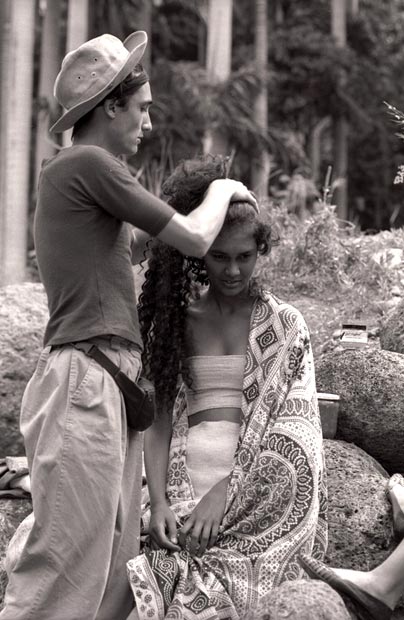 |
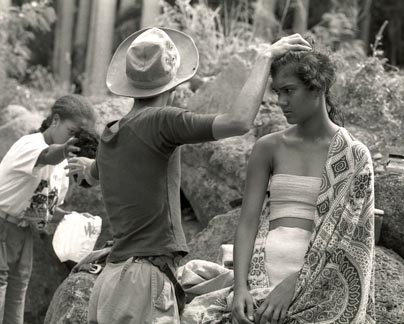 |
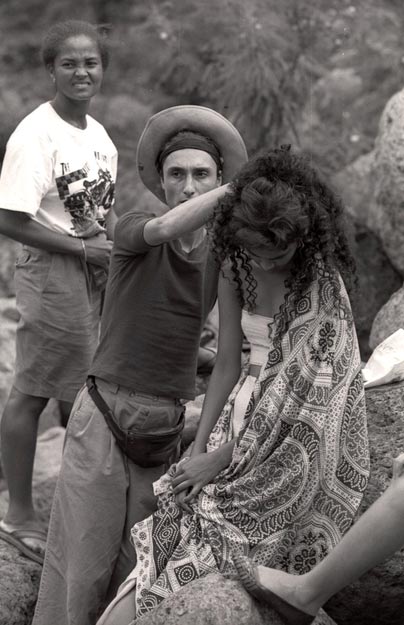 |
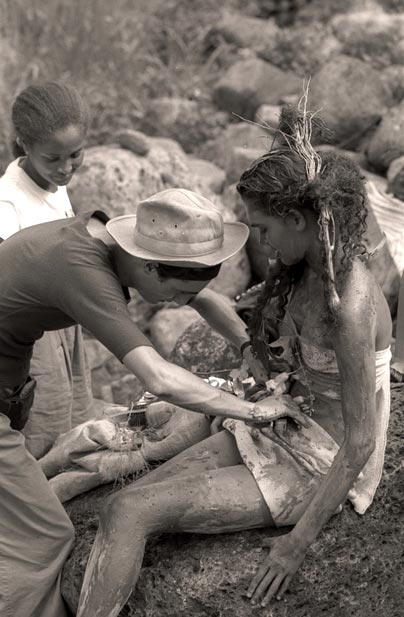 |
| Photos de Raymond Bartes |